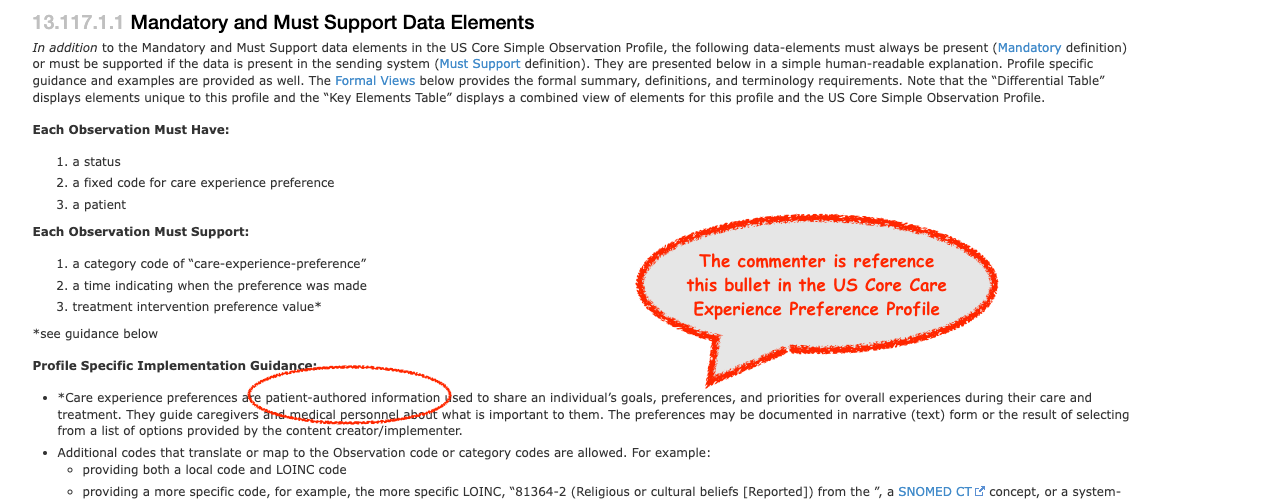Details
-
Change Request
-
Resolution: Persuasive with Modification
-
Medium
-
US Core (FHIR)
-
7.0.0-ballot
-
Cross-Group Projects
-
US Core Care Experience Preference Profile
US Core Treatment Intervention Preference Profile -
-
Brett Marquard / Lisa Nelson : 21-1-2
-
Clarification
-
Non-substantive
Description
The Treatment Intervention/Care experience preferences are modeled using the Observation. IF the intent is to capture the clinician's documentation of the patient's ADI verbally or transcribed interpretation, then the Observation is a reasonable resource to use. A subsequent clinician's Care Plan would use one or more of these observations to create appropriate Goals and/or ServiceRequests (of type plan) to address those preferences that the clinician can address. But if the preferences are in a truly patient authored document, the FHIR based model for that ADI should be based on CarePlan as well: the patient's authored careplan. Upon intake the clinician would review that (with the patient/caregiver) and make their observations, that in combination with the patient's authored documentation (if in computable form using the care pan structure) would yield a clinician authored care plan using the CarePan constructs.
USCDI US Core does not indicate the preferences are patient authored, rather patient expressed, which can be verbally and/or sharing a document in some form. Thus using Observation in FHIR US Core for the clinician to reflect their documentation and impressions of the patient's preferences is fine. But that means that the statement *Care experience preferences are patient-authored information used to share an individual’s goals, preferences, and priorities for overall experiences during their care and treatment. " is incorrect as that would require the use of CarePlan, using Goals and ServiceRequests where the author is the patient or their caregive, not Observation. And it is not what USCDI states.
We suggest that the profiles clearly state that these are clinician documented reflections of what the patient expressed, specifically, replace "*Care experience preferences are patient-authored information used to share an individual’s goals, preferences, and priorities for overall experiences during their care and treatment. " with "*Care experience preferences are patient expressed, clinician documented information about an individual’s goals, preferences, and priorities for overall experiences during their care and treatment." and similarly replace "*Treatment intervention preferences are patient-authored information used to share an individual’s medical treatment and intervention goals, preferences, and priorities. They guide caregivers and medical personnel when the patient cannot communicate." with "*Treatment intervention preferences are patient expressed, clinician documented information about individual’s medical treatment and intervention goals, preferences, and priorities. They guide caregivers and medical personnel when the patient cannot communicate."
Introducing the CarePlan to truly and properly express a patient's authored preferences in a structured, computable format would be a substantial step and is not what we understand the scope of USCDI to be.
Attachments
Issue Links
- is voted on by
-
BALLOT-57991 Negative - Hans Buitendijk : 2024-Jan-FHIR US CORE E7 STU
- Balloted
-
BALLOT-60163 Negative - Frank Oemig - Cerner : 2024-Jan-FHIR US CORE E7 STU
- Balloted

